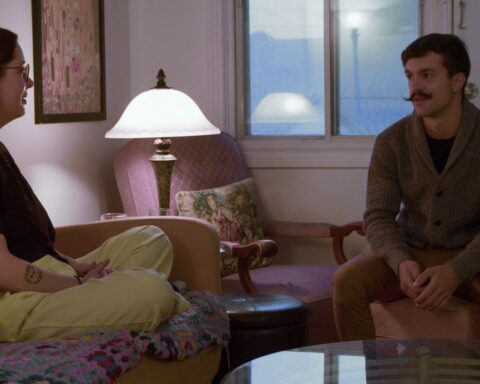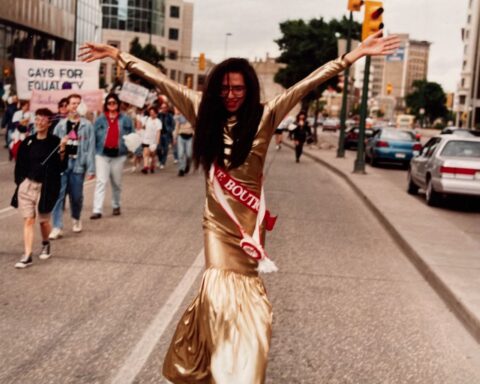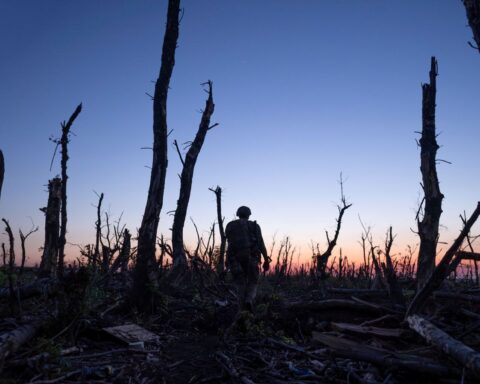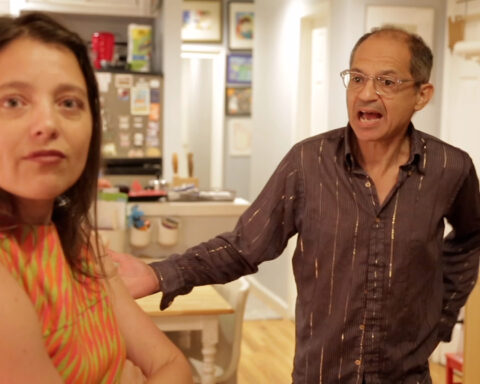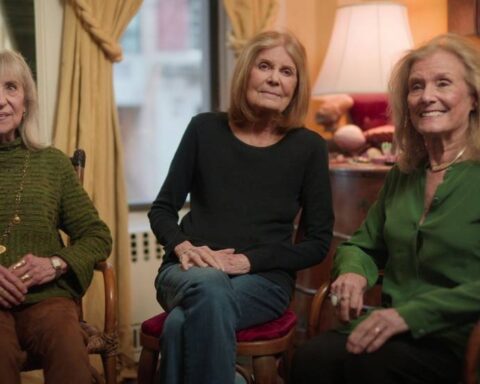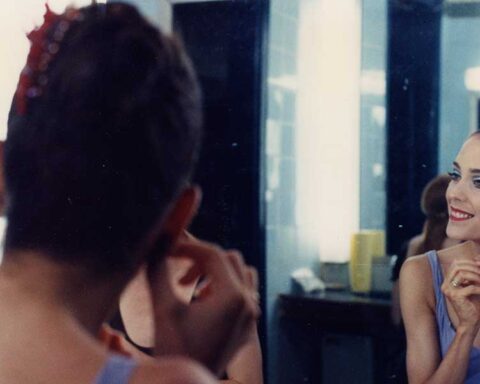Peter Wintonick was interviewed at great length by Pepita Ferrari for her acclaimed 2008 National Film Board feature Capturing Reality: The Art of Documentary. Less than five minutes of the footage from the interview was used in the film but all of it was archived by the Board. Ferrari and her producer Michelle van Beusekom have generously allowed POV’s Marc Glassman to edit and slightly revise the interview for this special issue of the magazine. We offer thanks to them and the Board, which produced two of Peter’s most notable films: Cinéma Verité and, with Mark Achbar, Manufacturing Consent. (We’d also like to thank Robin
McKenna for her editorial assistance.) A note: Peter Wintonick considered me his best editor and always allowed me to interpret his words to make them more effective. This may be my final stint as Peter’s interpreter and I take to this task with joy and sorrow. —Marc Glassman
PF: Pepita Ferrari | PW: Peter Wintonick
PF: When did you get started in documentary filmmaking?
PW: I got interested in documentary through my father. He was in the
Canadian Air Force, and would go off on trips along the East Coast of
Canada, defending the borders, especially during the Cuban Missile Crisis.
He would bring back little eight-millimetre images from those trips. My
father gave me a camera when I was eight years old and I started picking it
up and shooting in primary school. I think it was in Grade Six history class
that I first went out in Ottawa to do a neighbourhood portrait, knocking
on the doors of rich people’s houses to find out what they do. I discovered
that when you have a camera, you could do things that you wouldn’t do if
you were a normal civilian.
PF: Take me through the early stages of your career.
PW: I went to Carleton University, but dropped out after two years to go to
Algonquin College, where I studied film. I learned in very practical ways
almost everything I could know and use in my kind of filmmaking practice.
So, after graduating at the top of my class there, I went to Montreal, where
I worked as an editor on docs.
My first job was editing campaign films for the prime minister of Canada,
Pierre Trudeau. When he was re-elected as prime minister, I thought it might be because of my lowly work as a documentary film editor! (Gives
ironic Wintonick shrug.) But the interesting thing about working in a
film company like that, doing sponsored films and documentaries for
the post office was that you would sit around as an editor and listen to
the producers talking behind you, and their clients. It was a good position
to be in. You could learn about the industry without having to take
responsibility for it as an editor. So, I learned about politics when I was
editing campaign films for the prime minister, when the spin-doctors
would come in. Whether it was advertising agencies or government
sponsors, you could really learn about power politics, which is one
of the driving forces of the film industry. It was my training ground.
After about seven years of that, I gravitated into the nascent feature
film industry in Canada. I worked as an AD (assistant director) and
location manager among other roles. (Editor’s note: Peter was the coeditor
on the scandalously successful Robert Lantos production of In
Praise of Older Women in 1978.) I spent 18 months working on one
particularly hapless and useless Canadian feature film, Your Ticket
is No Longer Valid. I was very despondent after that experience and
when one is unhappy, one usually goes to a bar. So I went to a bar
during a film festival and I met this guy, and I asked him what he
did, and he said he was a documentary filmmaker. It was Ron Mann
and he asked me to go to Toronto to work with him on a film about
performance poetry. (Editor’s note: it was the 1982 doc Poetry in
Motion featuring Charles Bukowski, Michael Ondaatje and William
S. Burroughs, among others).
To some, it might have seemed to be a fall from the glamour of
feature films to documentary, but I had an epiphany. As an Ottawa kid,
I returned to my roots, to an overriding fascination with politics. So I
took what I call ‘a documentary vow of poverty,’ which meant that I
gave up the lifestyle of feature films, and all the money I was making,
and really started over again, on the career I’ve had ever since that time.
I went to Toronto and started working with filmmakers as a producer
or associate producer, but mostly as an editor. I always had a
structural view of the world, and of art, and the construction of things.
Maybe because I was very good in mathematics and architecture, I
could see the big picture in lots of little things, which is really what
an editor does. I was able to help a lot of young filmmakers in the
’80s, constructing their films, and letting them find their own voices
within the material they had. I was a kind of psychologist, getting
young emerging filmmakers to articulate their vision.
I had a mentor, Emile de Antonio, probably the godfather of
American political documentary, who didn’t start making his own
films till he was about 40 years old, and quickly became an enemy of
the state. The films he would make about Richard Nixon and Vietnam
(Millhouse: A White Comedy and In the Year of the Pig) rattled the U.S.
government. He was quite eclectic, a bon vivant, and he really motivated
me in the late-’80s to start working on my own films while still
sharing so much of my skill base with others.
In the late-’80s I started to make a film with Mark Achbar about the
American intellectual, linguist and media theorist, Noam Chomsky.
We dedicated that film, Manufacturing Consent, to de Antonio. Since
then I’ve been making a lot of my own docs, mostly in co-production
with others, and working internationally, creating a kind of metanetwork
of filmmakers, and actively participating in festivals, and
writing, and doing lots of things around the world of documentary
beyond just making films.
PF: Where does your commitment to documentary filmmaking come
from?
PW: It is a kind of religious exercise, I think, making documentary
films. I started studying different religions when I was 12 years old,
and maybe the one I really decided on for myself was cinema.
I feel that we have a responsibility to face reality and documentary is
probably the best way to do that. It is a visual medium, and I’ve always
been an observational person. When you’re like me, like many other
artists, you’re timid and shy in a certain way but you like to engage
and at the same time observe human behaviour. When you combine
that with analysis, that’s the documentary process.
When one starts to study the history of documentary, which is
something I encourage people to do, you start to see how important
documentary has been to the evolution not only of the art form of
filmmaking, but also to social movements, and government policy. For
me, documentary is about social engagement and political engagement
and how to change the world.
PF: To what extent do political and social activism influence your choice
of subject?
PW: I’ve always been a kind of pacifist, and, and admired people
who can transform societies like Gandhi, or like Martin Luther King,
or Mandela. I’ve visited places where they have worked and lived,
and really admire that kind of possibility for transformation. I think
documentary filmmakers are almost in that same kind of position, as
information machines, as transformative artists, as inspirational people
who can shine a light in the dark corners of the world, and illuminate
the horrors of the world.
One could be a Zen poet and live on a mountain and let the world go
by, but filmmakers have to be more socially engaged. The main mission
I put on myself was to look at our own industry, our own medium, our
own art form called cinema, called journalism, and to turn my lens
on the media. Really, almost all of my films are connected that way.
The media is probably the most ubiquitous and important thing in
the ether these days, and the people who control it, don’t take much
responsibility for what is on the air.
I feel my own kind of sense of responsibility is to act politically and
socially as an example of someone who doesn’t have to engage in a
kind of entertainment circus.
PF: What is your definition of documentary?
PW: For me, documentary is a way of illuminating truth through an
artistic lens.
PF: What are the main elements to consider for good documentary
filmmaking?
PW: I think like all cinema, and I won’t differentiate documentary from
the rest, are hybrids—mutated and unique kinds of art objects in and of
themselves, without definition. They are visions of original thinkers. I
won’t say, “There is a great documentary,” I’ll just say, “There is a great
film.” I see probably 4- to-500 films a year, so I have a very discerning
vision of what good is, and I really don’t think there are many very
good films around. Maybe three or four great films a year come across
my brain and my heart. And I would that the characteristics of a great
documentary or film really are those, which can transform the viewer
to change attitudes and how you view the world.
PF: How has documentary evolved over the last decade or so?
PW: A digital revolution has transformed the documentary. Lowcost
technology has liberated documentary filmmakers from a co-dependence on big financing schemes, which were more necessary
in the last century. New technologies have liberated documentary
filmmakers. Because our cameras are smaller and approaches are
different, we are able to insert ourselves into public circumstances in
more discreet ways, which allow us to better observe social movements.
The miniaturization of technology has allowed us to make more
personal documentaries. Too many of them are a kind of mindless
dribble but even those can be useful if people identify with them. New
technologies have helped different groups to take up cameras and train
themselves to use and reflect their own communities. It’s a democratization
of documentary, which has happened in the last 10 years.
New types of distribution systems have been developed with the
advent of the Internet. We find ourselves inserting documentaries into
YouTube space, into cellphone space, into lots of different kinds of
delivery systems. There’s been a hybridization of documentary, which
means that the form itself is no longer just a linear information-based
form. You can take from other art forms all the different expressions,
from animation to fiction, and combine them into a new kind of documentary
practice.
PF: What will be some of the major influences on future documentaries?
PW: I was a “thinker in residence” a couple of years ago in Australia,
and one of the projects I experimented with was trying to envision
what the documentary of the future would be. I think everybody will
be a documentary filmmaker, a kind of digital citizen. We’ll be able to
observe society and record it and be active in “surveillance” (surveyors
of society), playing the role that big media used to play as watchdogs.
We’ll all be wearing a documentary camera suit, which nobody will
actually know will be a camera. We’ll all be able to record, transmit
through a satellite, and beam down back onto a new kind of Internet,
which will not be the Internet we know; it’ll be some kind of biological
thing rather than a mechanical thing.
My vision of the future is not really about the machines; it’s about
taking a kind of ethical stance and imposing a set of visions and values
on the world. An active citizen in the future will be engaged in a
democratic process, pointing out injustices that are being neglected by
governments and corporations. In my kind of future, the digital citizen’s
main job, unpaid, of course, will be to record, reflect and change reality.
PF: You made a film on cinema verité in 1999. What was the importance
of the movement and were there any drawbacks to it?
PW: Cinema verité is a name for a movement that sprang up in the
late-’50s and ’60s, which saw cameras being taken onto shoulders
instead of tripods, and sound systems being liberated from umbilical
cords between the cameras and sound recorders. It really transformed
cinema because subjects could be free to engage with smaller crews, in
more informal settings. It was about free-flow and had a big influence
on everything from advertising to music videos to French “new wave”
cinema and other independent movements in fiction.
But traditionally, verité disallowed any kind of narration and was
kind of objective. You really pretended that the filmmaker didn’t have
an opinion; it was supposed to be just a recording of certain events,
or people going through different processes in their lives. Nowadays,
we want to get into deeper areas of reflection and hear different levels
of thought from the subjects and the filmmakers. I think life is more
complex than any camera can record and if you rely just on the basic
level of recording, which is what cinema verité is, you miss a lot of
layers of reality.
One of the major areas where many forms of documentary fail is that they don’t really reflect life as I know it. I think at least 50 per
cent of life is filled with humour. Despite the fact that I’m serious
when talking about documentary, I like to think that some of my films
have a modicum of humour within them. There are not really enough
documentaries that have or use humour as a strategy.
PF: When did you decide to take on Manufacturing Consent?
PW: Mark Achbar, the co-director of the film, and I went to Queen’s
University in Kingston, Ont., where Noam Chomsky was giving a
lecture. There were 1,500 people there listening to him talking about
South American and Central American politics, and we figured Wow,
for a small town that’s a big cult audience. And nobody had made
a film about Chomsky. We knew that Chomsky was a linguist and
a philosopher but we were more interested in his politics and his
analysis of media.
Chomsky and Edward Herman were releasing a book called
Manufacturing Consent, and we had applied for a little bit of arts
council money just to get us started in doing the research on our film.
Like all documentaries, you could either wait around until you got all
the money, which means you might wait around forever and not make
the film, or you could actually just start shooting and do the fundraising
in coincident kinds of ways.
We found out that the book was being printed at a little press in
Long Island, so we gathered up an old RCMP [Royal Canadian Mounted
Police] surveillance camera, which we liberated at a surplus auction,
and went to shoot the first scene of the film. We didn’t know that it
would take us five years.
PF: How much of the film is based on Chomsky’s book?
PW: Being a documentary filmmaker is a bit like being a farmer. You
have to spread out the seeds, and eventually harvest the crop. In this
case, the seed was the book, co-written by Chomsky and Herman,
who’s an economics professor in Philadelphia. They created a structure,
which looks at the way that our information system passes from the
mainstream, or agenda-setting media, on its way to the public. The
structure of the film is loosely based around looking at examples of
the structures and filters that information is going through.
Chomsky, being a kind of libertarian and anarchist, was quite
supportive of us making a film about him, with the limitation that we
wouldn’t make a personal, People-magazine kind of exposé portraiture
of him. But really we were trying to make a film about ideas rather
than personalities. So, he agreed to us being little gadflies—or fleas,
perhaps—in a cinema circus, which followed him around, in very
benign ways, for two years.
PF: What are your guidelines when it comes to how much you’ll expose
your subjects to public exposure, or possible government repercussions?
PW: I think the most important reason I got into documentary was not
to do with cinema. It was because I felt it is and was a kind of ethical,
philosophical enterprise. Almost every day, when you’re a filmmaker,
you’re challenged, and challenge yourself on these ethical questions.
Where are you getting your money from? How are you trying to seduce
a subject to give you permission and access to their stories? Essentially,
documentary filmmaking is a bit like being a vampire. We think it’s a
kind of noble enterprise—we’re revealing and capturing people’s stories,
and transforming them, and sharing them with people—but in fact,
we are sucking the stories right out of people. Appropriating stories
from different cultures. And sometimes that’s done with complicity, and sometimes it’s done with the best of intentions, but sometimes
it’s done because we have to feed the media machine with more, more
and more documentaries. So, for me almost every day is a challenge
on an ethical level.
One of the most important aspects of this ethical enterprise called
documentary is to protect the subjects that we’re filming: most of the
time their lives are on the line: they’re living in parts of the world that
are less privileged than ours. It’s a privilege to be there among them,
and asking them to share their stories. We’ll say to people sharing
stories, ‘Actual problems can get solved, and policies can change, and
the illumination of stories into a wider audience sometimes prevents
further injustice.’ Filmmakers have to feel humanly responsible, not
just during the capturing of those stories, but, I think, in the editing
of the stories and in the projection of those stories and distribution of
those stories into the world, so that people are protected.
PF: In Seeing Is Believing, why did you choose the stories you did?
PW: Most of my films are really about my own interests. One chooses
stories that resonate with one’s own politics, or one’s own heart, but
also are somehow cinematically rich. You have to find material and
characters that support your own points of view and arguments. In the
case of Seeing Believing, the main character is Joey Lozano, an activist
who has since died. Joey was in the southern Philippines in Minimao,
working for 15 years in service of the tribes of southern Philippines.
You really identify with his work, but once you meet him, you just fall
in love with him.
PF: How much of the film did you plan ahead?
PW: My colleagues and I are really great planners. I think you do have
to measure and plan every film like a logistics war, especially when you
have little resources in terms of movement and filming and schedules
and all these kinds of issues. I also like to have a visualization of how
a story will be told. When we’re writing our countless proposals for
films, the people that are giving you financing want to know at least
an approximation of how it looks. So do I.
It’s a combination, documentary is, of improvisation and opening
yourself up to spontaneity, and also superimposing a will upon reality.
A lot of that happens in the field as you’re shooting, but a lot of it also
happens in the construction of the film in the editing room.
PF: How was the story of Seeing is Believing visualized?
PW: A lot of the kind of stories are predetermined, or pre-imagined,
pre-visualized. If you observe human nature enough, you know that
certain stories will go a certain way, or you expect them to. So my
co-director Katerina Cizek and I were essentially following a camera
from New York City as it was donated from the Witness organization
(Editor’s note: an NGO co-founded by Peter Gabriel that uses video to
expose international human rights violations) to Joey, and we knew we
wanted to follow that camera. We knew that in the hands of Joey, he
would be using it as a tool for social change. And, with research, we
could imagine that there would be stages when he would train tribal
people, and put the camera through tests. Eventually there would be
some crisis and a conflict, and all those things that are kind of essential
for the telling of a dramatic story.
These are the things that you wish to happen, and, if you’re a good
filmmaker, I think your wishes generally come true, or you make them
come true, which is really, I think, what determines a documentary
filmmaker. We do have an impact on reality. Filming the world is
affected by the fact you’re filming, because it’s an art form.
Most of my films are essays, trying to figure out what the problem
is with the world, figuring out how a lowly little film can actually
change the world. In this case, we were looking intellectually at how
new technology, especially these little amateur video cameras, have
transformed the way we look at the world. We thought originally that
we wanted to find three different people, but documentary filmmaking
is an organic process. We found that Joey Lozano’s story showed all
of the things that we were interested in conveying.
We’re telling stories through other people, essentially. It is a kind of
symbiotic or organic relationship that a filmmaker has with a subject.
You’re pretending you’re telling their story, but, in fact, you’re telling
your own story, or you’re using them, in a way, to tell a kind of generalized
story, hoping that the specific individual’s story and character
will be a universal story. I think all film, and all documentary, is really
only about two things: time and memory.
PF: Has the film had a lasting impact?
PW: I take the greatest satisfaction from the people that come up to
me and say the films I’ve made have changed their lives. In the case of
Seeing Is Believing, that film, when shown in public combined with an
outreach campaign, got people writing letters to the president of the
Philippines. It also got seen broadly around the world in television,
which allowed the struggle of the tribal people there to be seen for the
first time. The work that Joey was doing, and Witness, in conjunction
with our—Katerina and my—work, was a part of a campaign which
alleviated some suffering, made the sugarcane and other corporations
there, who were conducting all of these death-squad campaigns, alleviate
that problem for a while at least, and put the rights of tribal people
and Aboriginal people in the Philippines on the agenda. So there are
some measurable kinds of impacts that films can have and human
rights films, especially documentaries, can change policy.
The same thing happened with Manufacturing Consent, around
the issue of East Timor. Academic studies have been made about the
impact of that film, which helped the East Timor Alert Networks and
campaigns in North America to recruit supporters for their causes. As
information tools, films can help persuade those in power that they
should take some kind of moral action. In the case of Manufacturing
Consent, it had a chain effect on policy so you had President Clinton
eventually starting to take some action. It gives me a certain pleasure
to think that films can change parts of the world.
PF: Talk about some of the editorial decisions you made while editing
Manufacturing Consent.
PW: Well, I guess because I’ve trained as an editor for 25 years in
dramatic films and feature-length films, my brain is structured like
an editing room. This is a way I look at reality, and I also believe that
films are constructed things, and these processes of taking hundreds
of hours of material and focusing down is a kind of fun challenge for
me, like a chess game or mosaic-making. In the case of Manufacturing
Consent, you boil all the material down into several hours, or a rough
cut. I took, with Mark, four hours of the film to Guelph, Ont., which
was having a little film festival. We asked the organizers if we could
show our rough, rough, rough version to the audience and ask them, for
about three or four hours after the screening, for feedback. We needed
to talk to them to figure out where the film made no sense, and where
it needed clarification, and if there were examples needed, and where
we were failing. That was a very helpful part of the editing process.
I’m not trying to make a film for myself, so it’s part of my responsibility to know what the market is. One goes through test-marketing: you take
your rough cut and get feedback. It was evident to me that we needed
to do a lot more work on the editing after Guelph and a couple of
other test screenings. We ended up spending another year editing. I
wanted to make the film more complex, so that almost every image
you can read in three different ways, conveying three different levels
of information. You take a basic level of a guy on a book tour—that’s
the road trip part of the story. You want to look at the history of propaganda
or other issues—and that’s the archival level. So you end up
spending six months looking through the archive database of the
National Film Board of Canada to see if any of those images can fit in
your big conception. And then you try to illustrate some of the more
philosophical, difficult areas as best you can. I take a lot of my influence
from advertising, because those are quick and wonderful little
ways of, within 30 seconds, creating messages with some kind of style.
The result is a film that can engage and entertain you on many levels.
PF: Can you describe the editing process in Nettie Wild’s A Rustling of
Leaves?
PW: I’m probably most proud of the editing of that, [of ] all of the films
I’ve been involved in making. I see the structure of that as one would
tell a very dramatic fiction film.
Originally the material was very chaotically organized, and there
were a lot of problems in the shooting. Materials were not synced
up properly because they were recorded in very harsh conditions on
small tape recorders.
But [I’ve] always liked, when I’m working with other filmmakers, to
try to watch all of the material at the beginning. I spent a really intense
two- or three-day period in which I watched everything. Nettie and I
talked after that but I found it was better if I edited in the room alone.
Editing is really done as a kind of mind game, in conjunction with
the filmmakers. I have this ability to remember everything somehow.
I remember every image I see on a particular film, hundreds of hours
of stuff. And then I start to formulate all of that stuff and structure it
in my brain.
I always like to put on some big board or chalkboard a proposed
structure: the way you can see the story told, the way the different
elements can interact, the way storylines flow together, the way the
major thrusts and themes are presented. The dramatic arcs of one
story can be three stories, or a dozen, and they each have major points.
So, I work like that. It’s a mechanical process of teasing out what you
imagine to be the stories, constructing very, very powerful scenes out of
material, which might not have been originally intended for that way.
In editing theory, when you take one image and put it beside another,
it has a certain meaning and when you put it in between two images, it’s
given a third meaning. It’s all about the context and the juxtaposition.
These are old lessons learned in the early days of cinema by Russians,
especially, and American short dramatic moviemakers that are really
still the lessons of editing. Things haven’t really changed very much.
The secret of editing is to totally surprise people so they don’t know
what’s going on to begin with, and what to expect. Your storytelling is
just slightly ahead of theirs, and you’re bringing them along with you,
but not alienating them so much that it’s into the realm of experiment.
You’re somehow leading them, and once you’re leading an audience,
you can take them anywhere. You do have a responsibility to at least
create the illusion of truth within the editing, to reflect the experience
of shooting, and to reflect the realities of the subjects that you’re filming.
You don’t want to manipulate people; you want to let them speak
for themselves in an honest way, because you know that the audiences
are sophisticated enough to discern who’s telling the truth.
PF: Are there special moments during your career that come to mind?
PW: I do love filmmaking generally because it’s a collaborative experience.
As much as we love the kind of intensity of the shooting stage
there’s always some certain moment, an aha moment when you’ve
found two pieces of film or images that go together in ways you never
expected. There are little pleasures that one gets in that kind of editing.
I think there’s about seven minutes of pleasure in any one filmmaking
process, assuming it takes you a year to make your doc. You have this
little bit of pleasure when you decide what kind of film you’re gonna
make. That’s like a minute of pleasure. And then the first money that
you raise for a film, it’s always for me, “Oh, there’s somebody else that
believes in my stupid passion.” There’s another minute of pleasure.
And then, you know, during shooting there’s always some beautiful
moments when you’re looking through the lens, and somebody’s telling
you something, and you really want to start crying, but you can’t
’cause you’re looking through the lens and you don’t want it all to be
blurry. And so, three minutes of orgasm.
And then maybe, you know, a couple of edits are really fantastic.
And then there’s the moment when it’s screened for an audience for
the first time. And, miraculously, they laugh where you want them to
laugh instead of laughing at the thing. That’s probably seven minutes,
but you get that pleasure every time you make a film. And, you know,
those seven minutes add up over a career.




